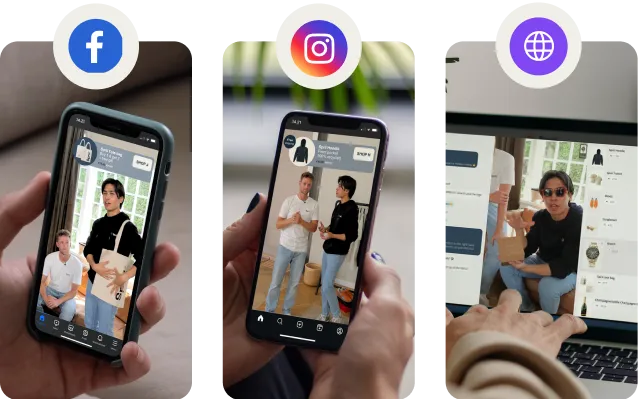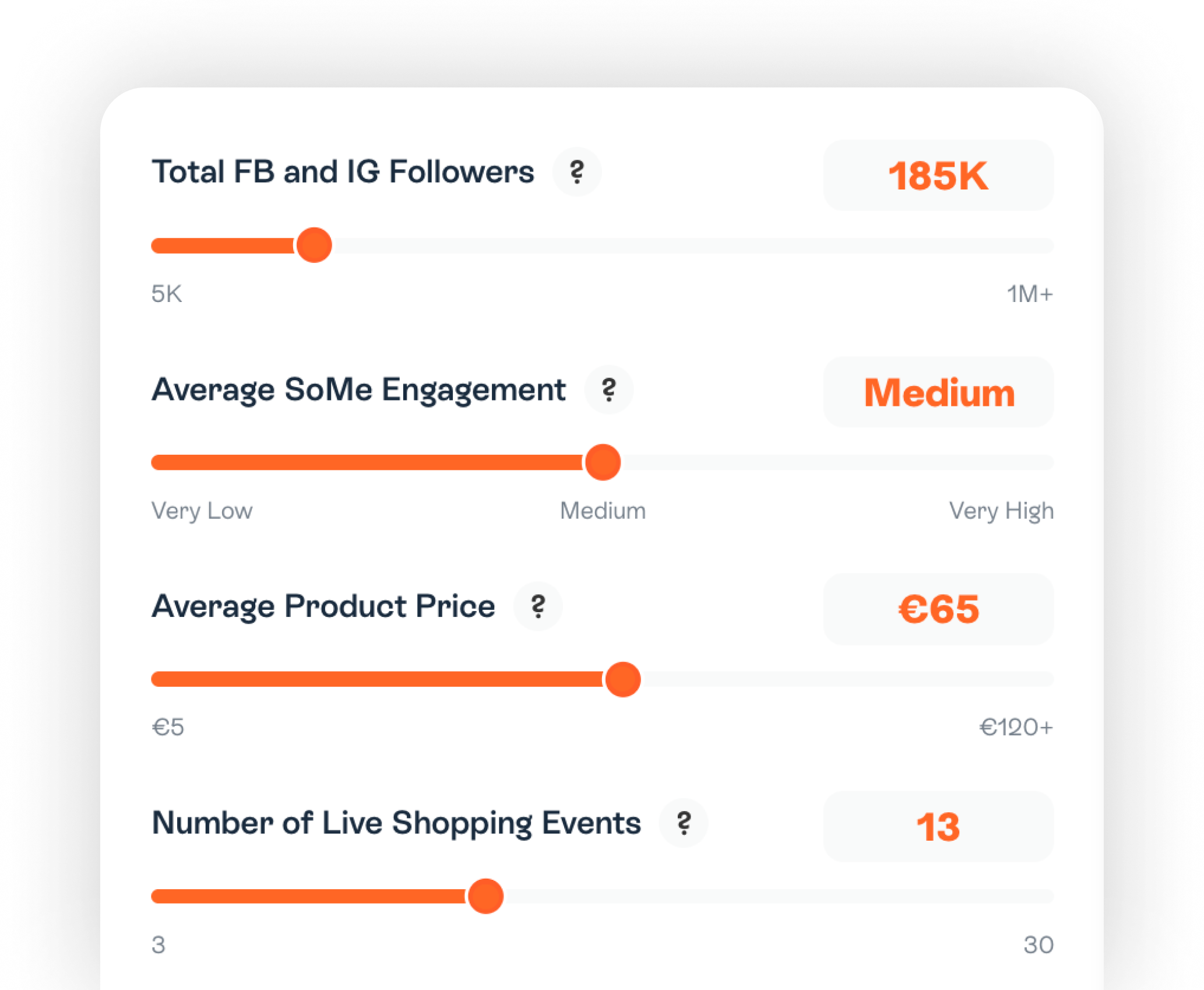Why live shopping is the perfect match with current consumer trends
Live shopping is a new method of selling for many brands, and it fits current consumer trends perfectly. Learn more about it here.


Beliefs and behaviors of consumers are constantly changing. And while new trends emerge, others slowly cease. A vast number of factors cause consumers to change their beliefs and behaviors, and it is always important for businesses to keep track. But more importantly; stay ahead.
Behavioural trends come and go. Some are short-lived. Some are sticky. Some may be accelerated or brought to a hold by coincidence. And some may be triggered by relatable trends or significant events.
The evolution and adoption of the digital world have undeniably been boosted by the recent pandemic. Such events create (among other things) urgency for creativity and transformation – and most likely, some trends begin to thrive among consumers.
As a concept, live shopping, live sales, or live commerce has been around since the launch of tele shopping. But with the rise of the internet and later social commerce, the concept has been adapted to a modern and more digital context and has since proved to be a valuable initiative in retailers’ omnichannel strategies.
Taking off as a proven concept in China, boosted by recent years’ events and now rapidly gaining foothold in Europe – live shopping has a major potential in the years to come. But what is it about live shopping that makes it interesting for both retailers and consumers?
The perspectives are many, but in the following, we will try to explain how live shopping is a perfect match to some of the major current behaviours and trends among consumers.
It must be convenient
You may have heard it before, but consumers demand convenience. But how do we define it? From the perspective of a consumer, a reasonable description may sound like something that simplifies, eases or otherwise makes us able to proceed without difficulty.
Convenience may, however, be interpreted quite differently depending on individual perspectives. Let’s take commuting as an example. Those relying on public transport may perceive convenience as easy check-in, heaps of departing times to choose between, good connections, and so forth. Those commuting by car may feel eased by adapting traffic lights, nearby gas stations, broad road lanes or easy access to road assistance.
The same differences apply to shopping. Some may say that convenience when shopping is a seamless and frictionless digital experience, while others perceive convenience as having easy access to human interaction during shopping. Just to mention a few examples.
{{20x-banner}}
Fortunately, live shopping combine quite a few of these perspectives on convenience. Let’s begin with looking at the purchasing flow: While laying on the couch or preparing a meal, consumers can tune in on live shows and easily – depending on the setup – view products, pick them, complete purchasing and have them delivered within a couple of days. Everything just by the means of a social media account and a smartphone.
For those perceiving convenience as human interaction, then there is an easy access to speaking to sales representatives in the live shopping session through the informal and often lively comment section.
Additionally, as people and as consumers, we ‘scroll’ through an immense amount of options and information daily. We often find ourselves overwhelmed and struck by some sort of decision fatigue – we simply can’t choose among options, because they are many, difficult to distinguish or have consequences attached that are challenging to see through.
Decision fatigue: When we are exposed to many options, we feel overwhelmed and have a hard time making decisions.
Source: Washington Post
Psychologically, it can be convenient to be faced with fewer options – or at least be guided toward the right decision. Again, live shopping has an inherent attribute that can accommodate us in this matter. Live shopping is all about showcasing what you as a retailer have to offer.
A retailer makes a deliberate choice about what to include in the limited set of products they want to show during a live session. And conveniently, this restricts the range of options that the consumers can choose from while also inspiring them in his/her phase of consideration.
Hopefully, live shopping will help us as consumers to avoid a marathon of scrolling through options.
‘Let me entertain you’
Compared to a time when brick-and-mortar was the only business-to-consumer sales channel, the competition for customers’ awareness has changed significantly since the introduction of the internet. The internet has paved the way for several new sales channels within e-commerce, such as webshops, online marketplaces and sale through social media platforms – also denoted as social selling or social commerce. The fight for attention and relevance is fierce. And it highlights the importance of a deliberate choice about how to interact with the customers.
Studies show that direct-to-consumer interaction on social media is on the rise. In the US and China alone (the front runner of live shopping), retail social commerce sales are expected to generate approximately $35-50 bn. and $300-350 bn., respectively, in 20211. And Europe is expected to follow suit soon. At the same time, consumers are becoming more interested in entertainment as part of their shopping experience.
70% of surveyed European consumers are interested in an entertaining element during shopping.
Source: Forrester
A study among European consumers shows that 70% are interested in an ‘entertaining’ element in their shopping. This element may unfold as videos, pictures, interactive contents and games – and especially live events.
Conclusively: Consumers are prone to use social media platforms for shopping – and they are in for an entertaining and interactive treat. Live shopping provides this treat. A live session is a window of oppor-tunity for personal interaction and socializing. But it is also a way to draw attention, provide a captivating presentation, and foster engage-ment.
It helps consumers to discover products but in a more interactive manner than what is possible through most other sales channel. It is all about creating an experience that adds value to existing and new customers.
‘Once upon a time’
Admit it. Everybody likes a good story. We know it from the feeling of a captivating book, a podcast or maybe an inspirational speech. And it’s well-known that retailers and brands can evoke the same feelings through story-telling. Story-telling about the store, the brand, or the products can create companionship and reason. It is a differential factor in the daily catalogue of endless options and alternatives that some-how all tend to look the same.
And yet another thing matters here as well: Consumerism is becoming increasingly conscious and demands transparency and authenticity. Consumers want to support and be a part of a cause or something they believe in.
Through live shopping, retailers can tell stories. The theme of a story can be anything that you may think is important to your audience. Why you are selling these products; where your products come from; why you love your customers; who you partner with; and so forth. Everything adds to the perception of you and your brand.
Some of the great stories are real and down to earth – and may not even have a theme or be well-rehearsed. Live shopping is about the moment. And this implies putting things on the line and even make mistakes. But it shows personality and the demonstrations become more authentic. Again, it adds to the story.
{{calculator-banner}}
‘I saw you on stream yesterday’
This last point is closely related to the previous. A recent study among Danish consumers shows, that the Danes opted to buy more from their local specialist stores during the pandemic than what they previously did. And 24-35% of the younger generation are asserting that they will continue doing that even after the pandemic2. That is great news for local stores.
But in a digital setting, it may be more difficult for e-commerce retailers to create intimacy and pre-sence the way a local shop normally can do. However, live shopping is an opportunity for pure e-commerce retailers to put their personality and faces into play – and thereby earn more customer intimacy. And on the other hand, live shopping gives the local stores a platform to spread some of the local vibes online.
Conclusion
Among other things, live shopping is convenient. And entertaining. It is a window of opportunity to tell a story, interact and engage with customers, and to create trust, loyalty and show personality. We are confident that live shopping is here to stay and that it will continue being an invaluable supplement to existing channels and create additional attraction for both the online and the physical store.
Discover how Live Shopping
can 20X your conversions
Experience Live Shopping with Sprii
%201.webp)
.webp)
.webp)

Live Shopping event works on FB, IG and your website

5 ways to win Black Friday




















.png)